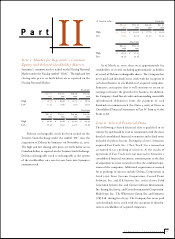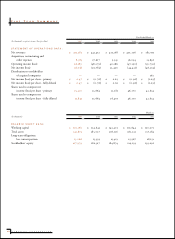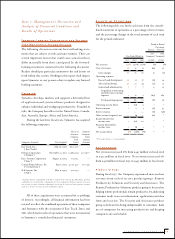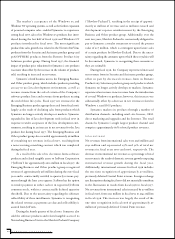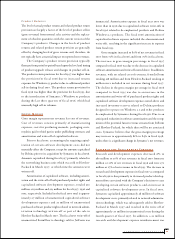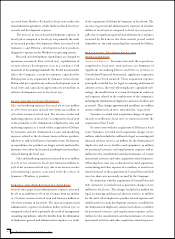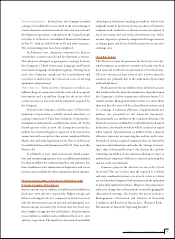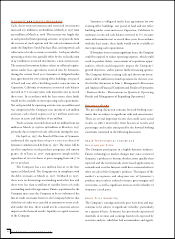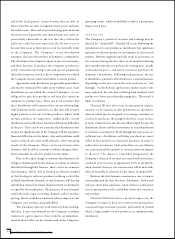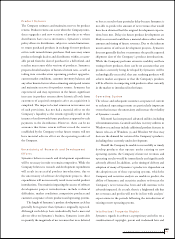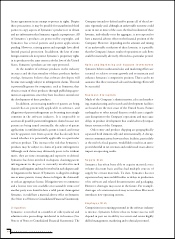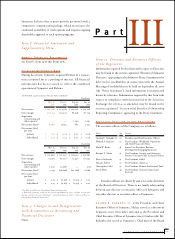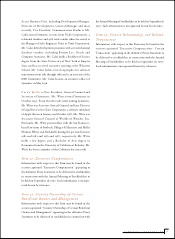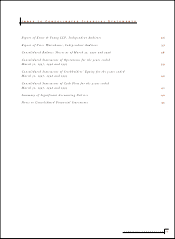Symantec 1997 Annual Report Download - page 29
Download and view the complete annual report
Please find page 29 of the 1997 Symantec annual report below. You can navigate through the pages in the report by either clicking on the pages listed below, or by using the keyword search tool below to find specific information within the annual report.
P r oduct Returns
The Company estimates and maintains reserves for product
returns. Product returns can occur when the Company intro-
duces upgrades and new versions of products or when
distributors have excess inventories. Symantec’s return
policy allows its distributors, subject to certain limitations,
to return purchased products in exchange for new products
or for credit towards future purchases. End users may return
products through dealers and distributors within a reason-
able period from the date of purchase for a full refund, and
retailers may return older versions of products. Symantec
prepares detailed analyses of historical return rates, as well as
taking into consideration upcoming product upgrades,
current market conditions, customer inventory balances and
any other known factors when estimating anticipated returns
and maintains reserves for product returns. Symantec has
experienced, and may experience in the future, significant
increases in product returns above historical levels from
customers of acquired companies after an acquisition is
completed. The impact of actual returns on net revenues, net
of such provisions, has not had a material effect on the
Company’s liquidity as the returns typically result in the
issuance of credit towards future purchases as opposed to cash
payments to the distributors. However, there can be no
assurance that future returns will not exceed the reserves
established by the Company or that future returns will not
have material adverse effect on the operating results of
the Company.
Uncertainty of Research and Development
Efforts
Symantec believes research and development expenditures
will be necessary in order to remain competitive. While the
Company believes its research and development expenditures
will result in successful product introductions, due to
the uncertainty of software development projects, these
expenditures will not necessarily result in successful product
introductions. Uncertainties impacting the success of software
development project introductions include technical
difficulties, market conditions, competitive products and
customer acceptance of new products and operating systems.
The length of Symantec’s product development cycle has
generally been greater than Symantec originally expected.
Although such delays have undoubtedly had a material
adverse effect on Symantec’s business, Symantec is not able
to quantify the magnitude of net revenues that were deferred
or lost as a result of any particular delay because Symantec is
not able to predict the amount of net revenues that would
have been obtained had the original development expecta-
tions been met. Delays in future product development are
likely to occur and could have a material adverse effect on the
amount and timing of future revenues. Due to the inherent
uncertainties of software development projects, Symantec
does not generally disclose or announce the specific expected
shipment date of the Company’s product introductions.
While the Company performs extensive usability and beta
testing of new products, there can be no assurance that any
products currently being developed by Symantec will be
technologically successful, that any resulting products will
achieve market acceptance or that the Company’s products
will be effective in competing with products either currently
in the market or introduced in the future.
Operating System
The release and subsequent customer acceptance of current
or enhanced operating systems are particularly important
events that increase the uncertainty and increase the volatility
of Symantec’s results.
Microsoft has incorporated advanced utilities including
telecommunications, facsimile and data recovery utilities in
Windows 95 and may include additional product features in
future releases of Windows 95 and Window NT that may
decrease the demand for certain of the Company’s products,
including those currently under development.
Should the Company be unable to successfully or timely
develop products that operate under existing or new
operating systems, the Company’s future net revenues and
operating results would be immediately and significantly
adversely affected. In addition, as the timing of delivery and
adoption of many of Symantec’s products is dependent on
the adoption rate of these operating systems, which the
Company and securities analysts are unable to predict, the
ability of Symantec and securities analysts to forecast the
Company’s net revenues has been and will continue to be
adversely impacted. As a result, there is a heightened risk that
net revenues and profits will not be in line with analysts’
expectations in the periods following the introduction of
existing or new operating systems.
Intellectual Property Rights
Symantec regards its software as proprietary and relies on a
combination of copyright, patent and trademark laws and
27
SYMANTEC CORPORATION


